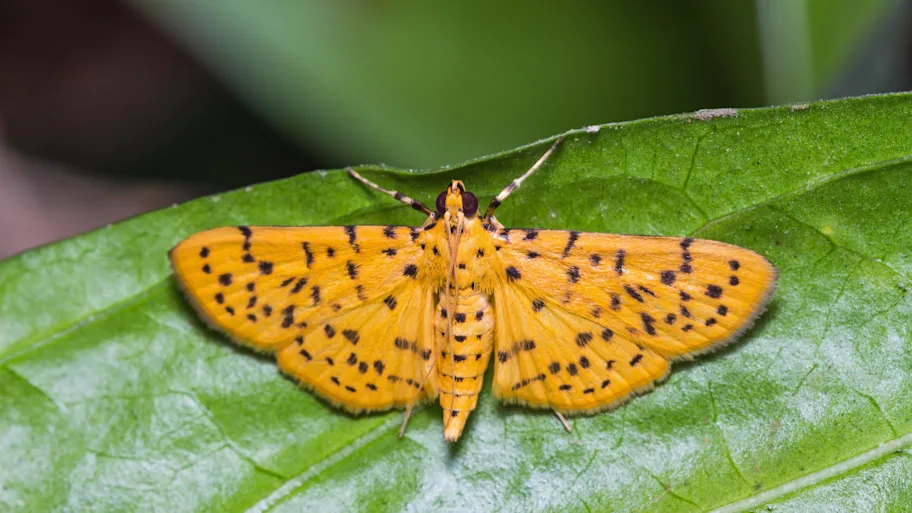
- Science news
- Featured news
- First release of genetically engineered moth could herald new era of crop protection
First release of genetically engineered moth could herald new era of crop protection
A newly published study reports a successful, first-ever open-field release of a self-limiting, genetically engineered diamondback moth, stating that it paves the way for an effective and sustainable approach to pest control. Image: Shutterstock
-- by Tania Fitzgeorge-Balfour, Frontiers Science Writer
For decades, the agriculture industry has been trying to find biological and environmentally friendly ways to manage the diamondback moth, which is widely resistant to insecticides. To combat this, a newly engineered strain of an insect pest performs well in US field trials conducted by Cornell University. Results show promise for future biotech crop protection applications and a potential solution to a global, multi-billion-dollar agricultural pest.
The diamondback moth, also known as Plutella xylostella, is highly damaging to brassica crops such as cabbage, broccoli, cauliflower and canola. This new strain of diamondback moth, developed by Oxitec Ltd, is modified to control pest diamondback moth in a targeted manner. The study showed the engineered strain had similar field behaviors to unmodified diamondback moths, with results offering promise for future protection of farmers’ brassica crops.
The Cornell study was led by Professor Anthony Shelton in the Department of Entomology at Cornell University’s AgriTech in New York and has been published in Frontiers in Bioengineering and Biotechnology.
First Field Release of a Genetically Engineered, Self-Limiting Agricultural Pest Insect: Evaluating Its Potential for Future Crop Protection► Read original article► Download original article (pdf)
Oxitec’s self-limiting diamondback moth is modified to control its pest counterparts in the field. After release of males of this strain, they find and mate with pest females, but the self-limiting gene passed to offspring prevents female caterpillars from surviving. With sustained releases, the pest population is suppressed in a targeted, ecologically sustainable way. After releases stop, the self-limiting insects decline and disappear from the environment within a few generations.
The field test builds on previously published work in greenhouses by Professor Shelton and colleagues that demonstrated sustained releases of the self-limiting strain effectively suppressed the pest population and prevented resistance developing to an insecticide, a win-win situation for pest control.
“Our research builds on the sterile insect technique for managing insects that was developed back in the 1950s and celebrated by Rachel Carson in her book, Silent Spring,” reports Professor Shelton. “Using genetic engineering is simply a more effiecient method to get to the same end.”
Male moths as a crop protection solution
Employing field and laboratory testing, as well as mathematical modelling, the researchers gathered relevant information on the genetically engineered strain of diamondback moth, whose wild counterparts cause billions of dollars in damage. The study was the first in the world to release self-limiting agricultural insects into an open field.
“For the field study, we used the “mark-release-recapture” method, which has been used for decades to study insect movement in fields. Each strain was dusted with a fluorescent powder to mark each group before release, then captured in pheromone traps and identified by the powder color and a molecular marker in the engineered strain,” explains Shelton.
Related: Don’t fear GM crops, they could help solve the sustainability crisis
Moth-proof results
The researchers were very pleased with the results of this comprehensive study.
“When released into a field, the self-limiting male insects behaved similarly to their non-modified counterparts in terms of factors that are relevant to their future application in crop protection, such as survival and distance travelled. In laboratory studies they competed equally well for female mates” reports Shelton. “Our mathematical models indicate that releasing the self-limiting strain would control a pest population without the use of supplementary insecticides, as was demonstrated in our greenhouse studies.”
“This study demonstrates the immense potential of this exciting technology as a highly effective pest management tool, which can protect crops in an environmentally sustainable way and is self-limiting in the environment,” says Dr Neil Morrison, Oxitec’s agriculture lead and study co-author.
Original article: First Field Release of a Genetically Engineered, Self-Limiting Agricultural Pest Insect: Evaluating Its Potential for Future Crop Protection






